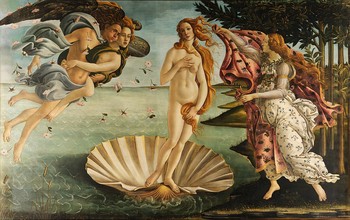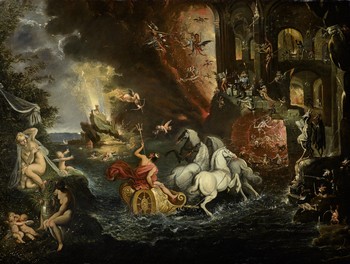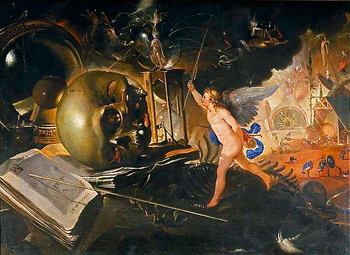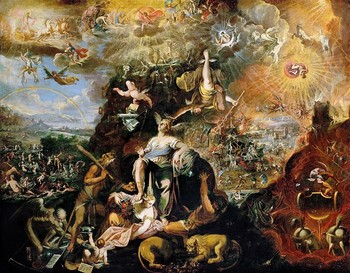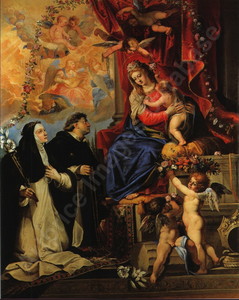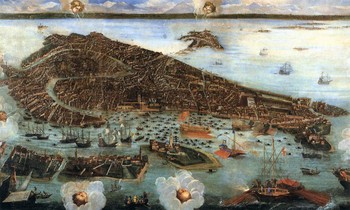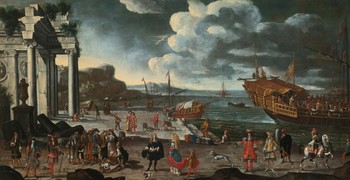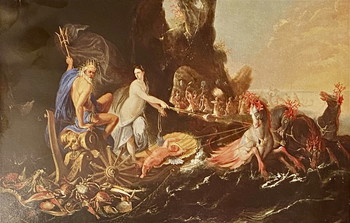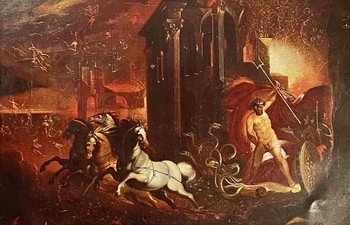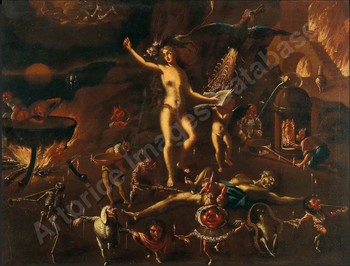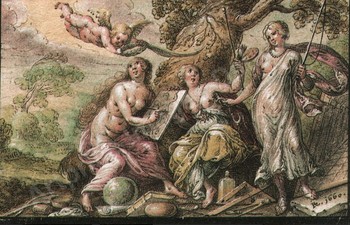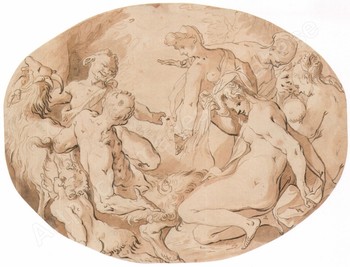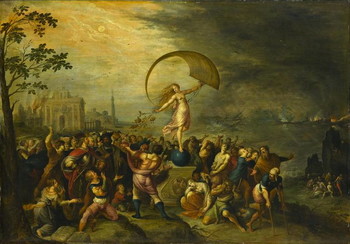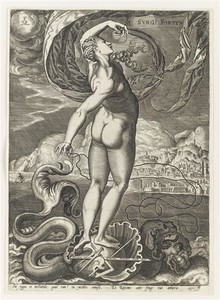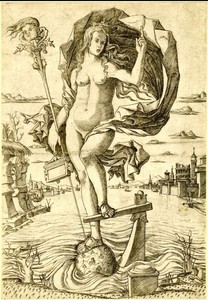Joseph Heintz II
Allegory of the Apocalypse
Oil on canvas : 150 X 175 cm
Signed and dated bottom left “IOSEFO HEINZ DI AVGVSTA F. 1674”
Vienna, Kunsthistorisches Museum
This is a comparative item

Painting for Sale
In short
Just as in Sandro Botticelli’s famous Birth of Venus (Uffizi, Florence) a tall goddess with long Venetian blond hair is successfully keeping a difficult equilibrium on a shell.
In our complex Vanitas painting Fortuna, the Graeco-Roman Allegory of Fortune, warns humanity for a difficult future ahead: a choice between peace and prosperity at left or war and destruction at right.
Joseph Heintz the Younger lost his father, also a well-known painter, at a young age. Our painter led during fifty years a successful career in Venice.
Certificate by Prof. Dr. Jan De Maere, 28/01/21
Fortuna Marina et Abundantia
The goddess Fortune, by definition unstable dispenses good and ill. She is depicted here in a maritime guise - the fragile boat (our destiny), represented by the giant oyster shell (as in Botticelli’s Venus), is afloat on an ocean full of dangers and volcanic eruptions. The capricious wind fills its sails. Fortune is accompanied by all her attributes, balancing on an oyster shell, serving as Cornucopia symbol of Abundance. Unstable, she pushes a youth (representing life) out of the safety of the shell, indicating her fleetingness. The white-red wings of putto at her right foot blowing soap bubbles indicates the same instability. She wears a golden monstrance as diadem, because God is our only savior through the Eucharist. The crown, scepter and wordily riches at her feet are all symbols of earthly powers and trades that are subject to the goddess’s volubility. The coins represent the transience of wealth, while a wise owl turns his back to all this vanity, represented by the presumptuous rooster.
The engraving by Bonasone (1555), imbuing the women with a sense of graceful serenity, could have been the basis of the first idea for this painting. Heintz also represents Fortuna in a calm state of being, taming her wild nature. He represents her as what she is not. Art is here used to counter “the wildness of fortune” (Andrea Alciati: Ars naturam adiuvans). The goddess of fortune and personification of luck pours her gifts on an array of undeserving animals. Traditionally Fortuna has her eyes covered and the vessel containing her favours is a horn of plenty (Cornucopia), is shown in an upright position; Heintz has reversed this tradition in his rendition and portrays the cornucopia at the feet of Fortuna. The figure of Fortuna divides the landscape in 2 parts: a prosperous one and disaster. Her golden hair is pushed by the strong winds of life to the happy corner and the sunlight.
Joseph (Giuseppe/Isepo) Heintz II the younger
Only nine years old when his father died, he studied under his mother’s second husband Matthias Gundelach after 1610. By 1625, he and Gundelach were already in Venice, where Joseph II became initially known for his copies and pastiches after his father’s inventions. Apart from a short trip to Rome (1644: Pope Urban VIII made him Cavaliere dello Spero d’Oro), he is assumed to have spent there the rest of his life. Following, as did Gundelach, the late mannerist style of his father, he adapted rapidly his fanciful Bosch-type subjects with monsters to the Italian taste. Few early works are known before his Last Judgment at San Antonio, Venice (1661). From the 20 paintings for Venetian Churches reported by his contemporary, the art historian Marco Boschini, only three are extant. The earliest dated work known, was sold at Dorotheum 4 March 1997 nr 8 (Madonna del Rosario con I Santi Domenico e Caterina di Siena, 265 x 200 cm, signed & dated 1642), seventeen years after his arrival in Venice. The present Fortuna figure represents the same facial type and characteristics as in this Madonna del Rosario. Also the two putti in this paintings are similar to the one in the Fortuna.
A pair of paintings: Le Triomphe de Neptune et d’Amphitrite and Le Triomphe de Pluton (Ader , Paris, 20 Décembre 1994 nr 23, 70 x 105 cm chaque) bear a great similarity with the ductus and style of the present Fortuna. In the Curti collection in Vicenza , there is a ‘Orpheus in Hell’ (R. Palluchini, La Pittura Veneziana del Seicento, plate 447, Milan 1981) close to the aforementioned paintings.
After carefully studying the Fortuna and Abundantia, and the works by Joseph Heintz II, it is my opinion that this Allegory originated in Venice at an early stage of the artists residence there.
About Joseph Heintz II
German painter active in Venice
Augsburg circa 1600 – in or after 1678 Venice
Painter of history (biblical, mythological and allegorical) scenes.
Son of Joseph Heintz I (Basel 1564 – 1609 Prague), who was also a painter of history scenes, a portraitist and an architect. At the age of twenty he travelled to Rome, where he stayed for a couple of years; here he came into contact with painters from the Low Countries. He also travelled to other Italian towns, Venice and Florence, absorbing also that influence. In the autumn of 1591 the Holy Roman Emperor, Rudolf II (1552 – 1612), an avid collector of Antiquities, of Northern Mannerist art and of scientific instruments, summoned him to Prague as ‘Portraitist and Court Painter’. Heintz Senior lived and worked between Prague, Rome and Augsburg.
Our painter lost his father at a very young age, probably before he turned ten, but he was strongly influenced by his art. Indeed his mother married Matthäus Gundelach (1566 – 1653), a painter who had been strongly influenced by Joseph I (he might have been his pupil), but also by Bartholomeus Spranger and by Hans von Aachen.
Upon Heintz’s death in 1609, Gundelach took his place as imperial Kammermaler to the Emperor, inherited his studio in Prague, married his widow Regina, acted as guardian to Heintz’s children and trained our Joseph II as his pupil. When Rudolf II died in 1612 Gundelach remained at the service of the new emperor, Matthias, until 1615. First he moved to Stuttgart, where he worked for the Duke of Württemberg, but in 1517 he finally settled in Augsburg.
Our Joseph II settled in Venice in 1625 at the latest. He remained here until his death circa 1678. He painted very diverse subjects:
- altar pieces for Venetian churches,
- rather revolutionary paintings inspired by Hieronymus Bosch, Pieter Brueghel I and Jacques Callot,
- Venetian veduti and feasts.
About our painting
A beautiful female nude figure representing Fortuna, the Allegory of Fortune, stands at the middle of a complex composition. At her feet is written in Latin “ne cedas: arduum parare”, meaning “do not give up, prepare for a steep, difficult road”.
This is a Vanitas painting, referring to the ephemeral, fragile character of life, to the choices that one can and must make. The left side of the painting shows prosperity and maritime trade. But the small putto is blowing soap bells where one can read “denique” and “nihil”, meaning “at the end there is nothing”: life is but a soap bell ready to burst. The cherub’s feet rest on crowns, golden coins, flowers that can fade and a trumpet, of which the sound easily gets lost. The cockerel shows this is the bright, dayside.
The opposite bird, an owl, introduces the dark, negative side of life. A dark youth with serpents points to a horrible vision of war, fighting soldiers, burning houses, a ship firing its canons. Nature crowns this haunting night side with lightning, while the dayside receives a golden shower. In a typical Late Mannerist manner our painter has enriched a traditional Italian 16th century Renaissance subject with many symbolic elements.
Like the famous ‘Birth of Venus’ painted 150 years earlier by Sandro Botticelli in the mid 1480s Fortune balances on a shell, her long blond hair and a scarf firmly blown to the positive side of the composition. Similarly to the Venus of Botticelli her body is anatomically not painted correctly and her pose is impossible to maintain: but then, when painting such a magnificent, imaginary figure, an artist may only rely on his imagination.
Why should you buy this painting?
Because the figure of Fortuna in this rich Late Mannerist masterpiece reminds of one of the most popular paintings of the Renaissance, the dreamlike Venus of Botticelli.
Comparative paintings
Click photos for more details

